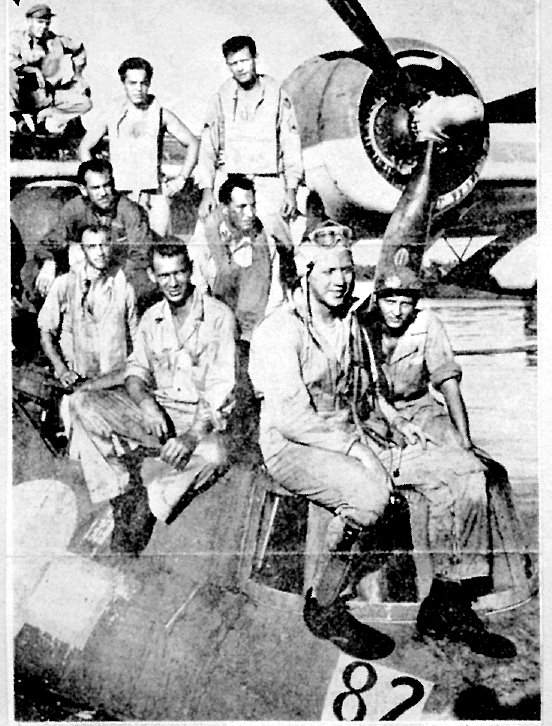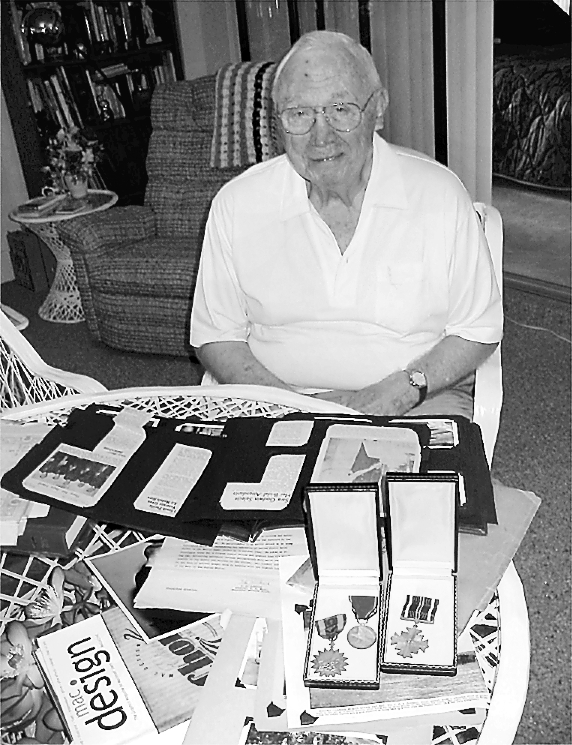He attacked the Yamato, world’s biggest battleship

From the smile on his face, it would appear that Woody Lindskog may have just returned to base in his Hellcat fighter. Photo provided
It was Ensign Woody Lindskog’s lucky day.
The Navy pilot was plucked from Wasile Bay off Halmahera Island in the South Pacific by an Army Air Corps Catalina flying boat, right under the nose of a Japanese gun emplacement and thousands of enemy troops after his Hellcat fighter was hit by an antiaircraft flak and crashed.
Lindskog, now 80 and living in Nokomis, Fla., splashed down in the bay with his fighter. He was floating about a mile from shore in a yellow one-man rubber life raft for awhile when the Army seaplane’s crew spotted him. A picture of the downed pilot sitting on the nose of the rescue plane with the crew of the Catalina appeared in Lindskog’s hometown newspaper back in St. Louis Park, Minn., shortly after he was picked up.

Ens. Paul Woodrow Lindskog, 21-year-old Navy flier from Minneapolis, sits with the crew of the seaplane which rescued him when his plane was hit by Jap Antiaircraft fire and forced down in Wasile Bay. Photo provided
The 21-year-old carrier pilot had been involved with the rescue of a fellow pilot; Ensign Harold Thompson of Chicago, Ill. Thompson was forced to bail out over the bay after his fighter was shot down, too.
Thompson was later picked up by a PT boat. Two torpedo boats negotiated an enemy underwater mine field to reach the downed pilot and bring him back alive.
A few months later in October 1944, Gen. Douglas MacArthur, together with Adm. T. C. Kinkaid’s 7th Fleet, began the invasion of the Philippine Islands. The Battle for Leyte Gulf from Oct. 23-26 involved three Japanese battle groups that included four carriers, nine battleship, 20 cruisers and 34 destroyers, among other enemy ships.
“The day before the attack our high command found out the Japanese were attacking in three groups,” Lindskog said. “They got word from our submarines the main part of the enemy fleet was sailing around the north end of the Philippine Islands into Leyte Gulf to attack us on the east side of the islands. While two other segments of the enemy fleet came through the Surigao Strait, just south of Leyte, the larger, more powerful enemy force would come through the San Bernadino Straight in the middle of the Philippine Islands.”
Lindskog and his squadron, Air Group 60, were flying off the jeep carrier USS Suwanee. His ship had originally been built as an oil tanker. He said it was one of 18 American carries that took part in the invasion.
“Our torpedo boats caught up to part of the Japanese fleet in the Surigao Strait. They clobbered ‘em,” he said. “They put one of the older Japanese battleships out of commission during the night fight. When dawn came, we were sent out to sink it. Our squadron plastered it with 1,000 pound bombs.
“When we landed back on the Suwanee, we were told not to get out of our cockpits. They gassed us up and replaced the machine-gun bullets and sent us right out again. That’s when they told us our squadron and a squadron of torpedo bombers were to harass the main Japanese fleet that included the battleship Yamato.”
For whatever reason, a dozen Hellcats flew off the Shawnee without bombs. All they had for armament were the six .50-caliber machine-guns in the wings of the fighters. The torpedo plans were just as bad off—they flew without torpedoes.
By the time they reached the Japanese fleet, all but two of the fighters had turned back because of engine trouble. Lindskog said he never saw the torpedo planes, but assumed they were there.
“We flew off in the afternoon. All that was left when I spotted the enemy was me and my executive officer. Flying at 15,000 feet, I could see the 34 ships below me. You could spot the Yamato right in the center of the fleet. It was as big as my hand. God, it was a monster.”

Rear Adm J.J. Ballantine presents Lt. j.g. Woody Lindskog of Nokomis, Fla. With the Air Medal for making a direct hit with a bomb on a Japanese gun emplacement while flying his Grumman Hellcat fighter in the Marianas Islands on July 24, 1944. Photo provided
It was their job to fly cover for the torpedo bombers who were supposed to be far below them, pressing their attack without torpedoes.
“The exec radioed the TBMs (torpedo bombers) that we’re about to dive on the fleet and keep on going. ‘So you better get your butts in and out of there in a hurry,’” he recalled.
“The executive officer told me, ‘Okay, you’re on you own.’ He peeled off and headed down toward the Japanese fleet.”
Lindskog was flying all by himself, watching fire from the enemy guns climb higher and higher and closer and closer to his plane. He figured 300 to 400 guns were aiming at him as he started his attack on the largest battleship ever built almost three miles below.
“My thoughts were, ‘I’ve been looking for you guys, and I’m gonna get my two bits worth right here,” he said. “I went right straight down at full throttle as my supercharger kicked in. I thought I would pull the wings off the plane, I was going so fast.
“I picked out the Yamato because it was the biggest target I could hit. I knew there was an admiral, a captain and a bunch of commanders aboard that battleship. I was sure the admiral was so proud of being the commander of the world’s largest and strongest battleship.
“I was gonna show ‘em all that one ensign in the U.S. Navy was worth five Japanese admirals,” he said with a smile. “I thought I’d give them a squirt with my machine-guns. You weren’t suppose to hold your finger on the trigger because you’d burn the barrels out of the machine-guns. “Then I thought that it didn’t make any difference because these barrels were gonna be at the bottom of the ocean in a couple of minutes.”
His Hellcat was spewing three streams of .50-caliber machine-gun bullets from both wings as his fighter approached the limits of its structural endurance. Flak was so heavy from the enemy guns below that he could hardly see his target.

Ensign Woody Lindskog stands in front of his Grumman Hellcat fighter plane. He was a member of Navy Air Group 60 that was part of Adm. T.C. Kinkaid’s 7th Fleet. Photo provided
“As I was going down, I thought to myself, ‘I’m going to ruin the admiral’s paint job,’ I knew I couldn’t sink him, but I thought, ‘Maybe some of my .50 caliber bullets will do some damage.’ I knew there was gonna be pock marks all over the battleship from my bullets.
“I held my finger on the trigger. I had him! If I could have had a 500-pound bomb I would have wiped out everybody on the bridge of the Yamato. It was the most perfect bomb run I ever made in my life and I didn’t have a bomb. The Yamato was growing and growing and growing as I dove toward it. Everyone in the fleet was firing at me. I couldn’t believe I was still in the air.
“When I pulled out of my dive, I couldn’t have been more than 15 feet above the water. ‘I made it,’ I though as I flew away.
“I was just barely above the water when three water spouts appeared out of nowhere off one side of my wing. The Japanese were firing all three of their big, 18-inch guns from one turret in front of me hoping to send up waterspouts I’d fly into and crash,” Lindskog said. “I took evasive action, flying up and down very erratically.”
He escaped the big Japanese fleet without a scratch, and his Hellcat had no major mechanical problems.

Woody Lindskog has a scrapbook full of memories. In the foreground are several medals he received for valor during World War II. The medal by itself on the right is the Distinguished Flying Cross he was awarded for attacking the Yamato, the largest battleship ever built in his Hellcat fighter. The two on the left are Presidential Unit Citations and the Air Medal. Sun photo by Don Moore
“I radioed back to the carrier. They told me to come in slow at 1,000 feet with my wheels down,” he said. “They were a little jumpy about airplanes getting too close by that time. I started getting the shakes. I thought, ‘You damn fool’ as I headed for the ready room. A buddy of mine came in a few minutes later and asked, ‘Where the hell have you been?’”
His friend informed him his Hellcat had just been pushed over the side of the carrier. They didn’t want to bother with it. It looked like a piece of Swiss cheese because of all the holes in it from enemy antiaircraft fire.
Despite the fact Ensign Woody Lindskog and his executive officer attacked the biggest battleship ever built with nothing but machine-guns and the torpedo bombers that flew with them had no torpedoes, all of the pilots safely returned to the Suwannee.
“This was my chance to get in the war big time,” the old aviator said 60 years later. “All I could think of was, ‘Oh God, give me a 1,000-pound bomb and I’ll put it right on the bridge.’ I had ‘em! And I was pretty damn good at bombing.”
Lindskog’s File
 Name: Paul W. Lindskog
Name: Paul W. Lindskog
Age: 81
Hometown: Minneapolis, Minn.
Current: Nokomis, Fla.
Entered Service: 23 December 1941
Discharged: 17 October 1945
Rank: Lieutenant
Unit: Air Group VF 60
Commendations: Distinguished Flying Cross, Presidential Unit Citation, Air Medal
Married: Mary Elizabeth Lewis
Children: Eric and Jon Lindskog
This story was first published in the Charlotte Sun newspaper, Port Charlotte, Fla. on Sunday, January 25, 2004 and is republished with permission.
Click here to view the War Tales fan page on FaceBook.
Click here to search Veterans Records and to obtain information on retrieving lost commendations.
All rights reserved. This copyrighted material may not be republished without permission. Links are encouraged.